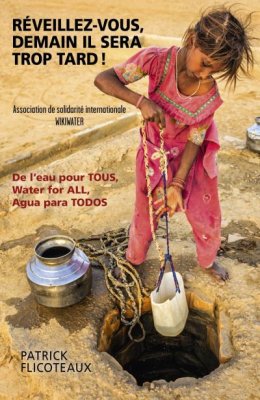1) What is involved ?
Every year, several million people of whom the majority are children die from diseases linked to unclean water at the source or contaminated due to a lack of hygiene. It is therefore indispensable to make the populations concerned aware of these problems. This awareness is guided by a certain number of general principles put forth in this fact sheet which are at the source of many methods which make it possible to :
- assist the populations concerned in becoming aware of the importance of hygiene and health issues concerning water and sanitation.
- have them participate in developing solutions to these problems in order to make them accountable and make them actors in their path towards satisfactory hygiene conditions.
- finally, educate the young generations in order to perpetuate the actions implemented.
As such, there are many methods ; here is a list (incomplete) :
- the PHAST method (Participatory Hygiene and Sanitation Transformation)
- the CHAST method (Children Hygiene and Sanitation Transformation)
- the SARAR method (Self-esteem, associative strength, Resourcefulness, Action planning and Responsibility)
- the MARP method (Method Accelerated by Participative Research)
- the APT method (Advanced Participation Technique)
- the GRAAP method (Research and Support Group for Self-Promotion of Populations)
- the CLTS method (Community Led Total Sanitation)
- the method of using specific guides
These methods have a large number of similarities, although that in addition to the general principles that guide them and that this data sheet explains, details will be provided only for the PHAST and MARP methods, and the method for the specific guides in respective sheets C2, C3 and C4 of the same name. The CLTS method can be consulted using the links at the end of the data sheet.
Note that the PHAST method stems from the SARAR method and that the latter is also described briefly in the data sheet devoted to the PHAST method. Likewise, the CHAST method is an adaptation of the PHAST method for children.
Finally, the CLTS method is specific to sanitation and differs from the conventional approaches of sanitation programmes by focusing primarily on the need to implement above all for awareness efforts and getting the global commitment of the communities to change behaviours of the entire population in a sustainable way, especially concerning open defecation, rather than just simply being happy with building latrines.
2) Who use this means and since when
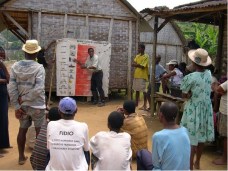
Awareness effort for the population in Madagascar. Photo Interaide
This means is especially used in developing countries. After it was introduced in the 1970s under the impetus of UNDP, it is now in general use today thanks to support from governments, many NGOs and UNICEF.
3) Why ?
Simple access to water cannot guarantee that the latter can be consumed without danger if a minimum of precautions of hygiene are not taken, and also in terms of sanitation. However, setting up programmes that make it possible to facilitate access for all to water and sanitation in good conditions cannot be done without active support from the populations concerned. It is therefore necessary to alert, educate and make the populations concerned accountable in terms of the stakes concerning healthy and sustainable management of hygiene and health issues with regards to water. For example, water can be contaminated when it is transported from a well to the home (due to improperly washed buckets, insects, heat, etc.) and become a vector for diseases such as severe diarrhoea which alone are responsible every year for 1.8 million deaths.
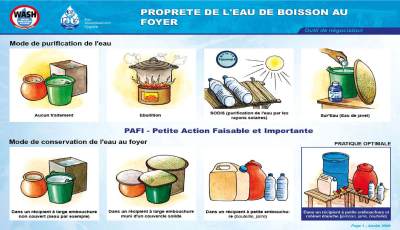
Awareness panel for simple means of treating water at home. Source : WASH and PSEau
4) Who is primarily concerned ? Locations or contexts in which these means seems most suited
First of all, all populations that do not have satisfactory access to water and to sanitation, without however excluding those that already have access.
Initially, these programmes were created to assist community groups (rural villages, small towns, etc.) as it is easier to involve a limited number of people and as members of the same group or community, since they share the same living conditions. However, education and awareness campaigns can also be implemented on a larger scale, such as is the case for example with the State of Mali.
5) What does this process involve ? How is it used ?
Over time and with experience, a few methods have emerged which have each shown their worth in certain given situations. This data sheet covers the general principles that are common to these methods and data sheets C2, C3 and C4 address three methods among the most pertinent and explain how they are implemented, their advantages and their disadvantages. But the reader must keep in mind that other methods can exist or be created and that there is no universal method : one must constantly strive adapt to get inspiration from these methods rather than attempt to apply them as they are in order to provide a satisfactory answer for each situation, a situation which is necessarily unique.
Here are the many points that these methods have in common in their broad guidelines :
- an information and communication campaign is a prerequisite condition before implementing any WASH project (Water supply, Sanitation and Hygiene projects). One must be fully aware in fact that local populations rarely welcome any changes to their practices which seem to them to come from the outside. In addition, they may not initially see the interest. It is therefore necessary to deploy much effort in terms of discussion, concertation, dialogue, and therefore a lot of patience and perseverance to hold meetings with all of the components of the population (notable people, the young, women, etc.) and bring them progressively to change their attitudes with regards to the project.
- this communication campaign, which in addition to meetings can require door-to-door efforts or that in the form of street theatre, must allow the populations to narrow in directly on their problems and to identify them clearly.
Finally, it is important that the following steps be carried out by the populations themselves, in general with the assistance of a team of "leaders" formed if possible from among the members of the community. The role of these leaders is to ensure dialogue and suggest activities and events that ensure that each member of the community feels concerned and above all feels that they are participating in the decisions that are being made.
Once the team of leaders has succeeded in adding momentum to the group-wide emulation, synonym of citizen involvement in the interest of the community, the remaining steps are :
- planning the various phases of a project making it possible to solve the problems that were identified in the initial step.
- carrying out these steps.
- monitoring and assessing the practices implemented in order to improve them and make them sustainable.
6) Special difficulties and remedies - Precautions to be taken, if any
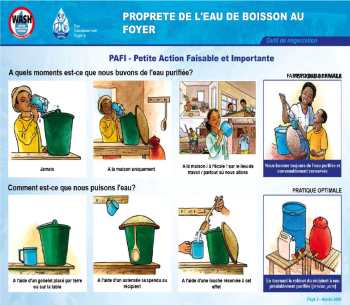
Awareness panels on cleanliness issues in the home
Source : WASH and PSEau
The process of implementing a WASH project is a long-term undertaking. It involves mobilising, making aware, negotiating and convincing all of the different components in the population in order to require the adhesion of all for a change that is well understood and desired in behaviours and in order to improve their lifestyle and conditions of life.
It is therefore essential to correctly carry out the first step where the populations themselves identify, with the non-directive assistance of the leaders, their own problems so that they can take ownership of the project. As such, it is obvious that one must refrain from any ethnocentrism.
Moreover, it is preferable whenever possible and when the population concerned is numerous or spread out over several villages or sections of town, to first carry out a survey in the field by leaders or specialised survey takers, who for example have some knowledge in ethnosociology (science concerning the social behaviours of ethnic groups or of groups of families) in order to be able to detect and more quickly understand the social and behavioural problems of the populations concerned.
7) Main advantages and drawbacks
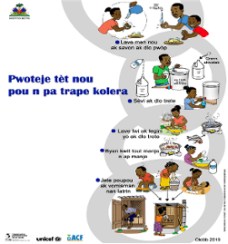
Awareness poster on the problems with cholera.
Source : UNICEF and ACF
The advantages and disadvantages concerning each method are developed in the corresponding fact sheets.
With regards to all of the methods, the following points can be made.
a) Advantages
1. The setting up of education and awareness campaigns as to the problems of hygiene and health concerning water and sanitation have shown to be a judicious investment in the short, middle and long term in favour of the economy, education and health.
2. The project under consideration, requiring the involvement of the populations, has a better chance of being more easily accepted, when it does not have the "assistentialism" effect.
3. Such campaigns generally make it possible to make populations aware of all of the problems of hygiene and health : water, sanitation, general hygiene and health.
b) Disadvantages
1. The various methods assume that the populations themselves are able to identify their problems, which is not always the case, which is why it is important and that trained leaders be present who are able to provide a point of view from the outside or get around certain taboos.
2. They require a lot of time in terms of involvement and patience.
8) Cost
The cost of a one-year awareness campaign is estimated to be a few thousand Euros (5,000 to 6,000) for 10,000 inhabitants. For example, the women employed by the EAST association to carry out a major sanitation project in Africa were paid part time for eight days of work per month (they scoured the wastewater channels and also doubled as informants).
EAST felt that it was necessary to call upon a sufficient number of people, here a little less than 100 people for a town of 10,000 inhabitants.
Of course, this cost can vary greatly (if one want to also set up a campaign in the schools, for example) but a cost of about 1€ for two inhabitants can be retained. This cost can become more affordable in grants are obtained or if revenue can be drawn from the measures that are set up. As such, the wages of the women paid by EAST come in part from the revenue stemming from the public latrines installed by the association in the framework of the project involved.
It is also important when developing budgets to pay special attention to inflation rates which can be very high in developing countries.
9) Observations, recommendations and suggestions
The approach to issues concerning hygiene differs from one region to another, it is therefore necessary to try to take into account the local particularities in order to define the most pertinent method possible. The leader will furthermore have to make sure to implement adequate communication tools (educational charts, diagrams, audio or video support) in order to facilitate the debate within the community.
Of course, these methods are not miracle recipes and they are very often just tools participating in a more global approach. It is in particular essential before starting a project to have three surveys carried out by specialists :
- A survey on the existing situation : sanitary, technical, economic (then require participation in terms of the means) and political (know the forces that are present on a local level, especially at the town hall).
- A survey on the knowledge of the population, on its level of education.
- A survey of the ethnosociological type on the practices, habits and behaviours of the population.
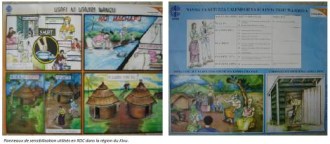
Awareness panels used by Caritas DRC in Kivu. Photo Caritas
Success stories must be shown and influential people must be invited to discover the places where the projects carried out have resulted in improving the living conditions.
In order to be effective, the duration of the awareness period must be at least one year, even if the methods themselves can last for a much shorter period of time.
People must therefore be trained who will continue to make their fellow citizens aware once the awareness effort is completed.
It is important to ensure the involvement of marginalised and economically underprivileged populations and especially women, who are often excluded from the decision-making process. The other population with priority is of course that of schoolchildren for whom it is necessary to devote at least four sessions per year. It is recommended to try in agreement with teachers to include sanitary education booklets in the programme which will give rise to questions that are adapted to the level of the students.
Two points are fundamental in order to allow for projects to succeed. On the one hand, the behaviour of the leaders who, while they are present, place the community at the centre of the action and discussions (the leader is an enlightened facilitator). On the other hand, developing tool kits that take cultural characteristics of communities into account and which are updated and brought to life by the leaders.
10) Example of good practice
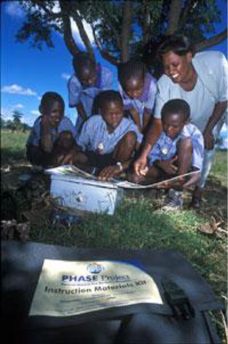
Photo AMREF
AMREF (African Medical and Research Foundation) South Africa in 2003 set up a one-year pilot project called PHASE (Personal Hygiene And Sanitation Education), in collaboration with the National Health Department. This project aimed to improve the health of several school communities in the Eastern Cape and Kwa Zulu Natal schools, through hygiene and health measures. The project made use of different participative methods in order to sustainably improve health in the school communities. In 2006, AMREF decided to expand this programme to other schools.
Recognised for the success of this project, the Health Department of the Sakhisizwe district received First Prize from the Regional Government.
11) Where to obtain further information
a) Websites
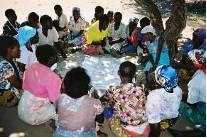
PHAST event in Mwambo in Malawi. Photo Inter Aide
Links to French websites :
- Water academy and the French Red Cross : Interesting 32-page guide on "methods for making aware, informing and educating audiences on the problems of water", available by clicking on :
http://www.academie-eau.org/admin/f...
- ENDA-Third World. Interesting and illustrated 12-page document summarising the main characteristics of 8 methods for awareness efforts in participative or community management methods
http://www.sadieau.org/opencms/open...
- FAO : 4-page document explaining the MARP method :
http://www.fao.org/participation/fr...
- PSEAU. Document providing an example of the use of the SARAR method with ESF and CREPA (Regional Centre for Drinking Water and Sanitation) : in the villages of Yona, Bana and Ouana (Burkina Faso) in the framework of the "Health through education on hygiene and the use of water" project
http://www.pseau.org/outils/actions...[]=258&tout=1
- AMREF, Various documents pertaining to its programmes on disease prevention and on using the PHAST method in South Africa or in school environments :
http://www.amref.fr/programme/defi-...
http://www.keewu.com/IMG/pdf/Projet...
http://www.youphil.com/fr/article/0...
- INTERAIDE : Adaptation of the PHAST method in Malawi :
http://www.interaide.org/pratiques/...; or : http://interaide.org/pratiques/site...
- 80-page manual on the methods for carrying out projects and on awareness efforts in terms of sanitation in so-called CLTS communities "Community Led Total Sanitation" by Kamal Kar and Robert Chambers
http://www.communityledtotalsanitat...
- UNICEF Mali : Recent CLTS guide (January 2011) with 49 pages which, using experiences concerning sanitation carried out in 350 communities in Mali, gathers together some principles and tools for implementing CLTS
http://www.communityledtotalsanitat...
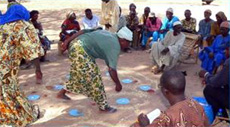 | 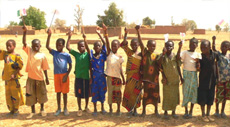 |
Awareness sessions for adults and children in Mali for the CLTS method for sanitation Photos Unicef Mali | |
- WHO (World Health Organisation), UNDP and the World Bank
Illustrated 56-page book explaining the PHAST method "The ’PHAST’ Initiative - Participatory Hygiene and Sanitation Transformation – A new method of working with the communities."
http://www.bvsde.paho.org/bvsacd/wh...
- CINAM (Industrial studies and improvement company-Montpellier) : train-the-trainer booklet on "The village water source". A comic strip and several sheets – 1.8 to 1.16 – explain what the health problems are linked to unclean water and a few methods for correcting this. Available (online) on :
http://www.pseau.org/outils/ouvrage...
Links to English websites :
UNICEF/IRC Developing ; “A Manual on School Sanitation and Hygiene materials and methods”
http://www.unicef.org/wash/files/Sc...
b) Bibliography
UNICEF (but in English) : Booklet on the Quality of water and promotion of HYGIENE (see pages 76 to 84 in particular)



